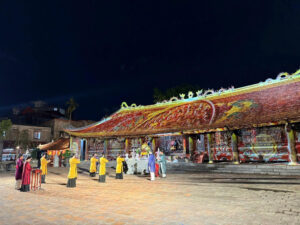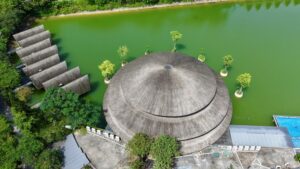Hoi An, an exceptionally well-preserved example of a traditional Asian trading port, is an outstanding material manifestation of the fusion of cultures over time. It was recognized as a World Heritage Site by UNESCO.
The town has been completely and assiduously preserved: it is the only town in Viet Nam that has survived intact in this way.
Most of the buildings are in the traditional architectural style of the 19th and 20th centuries. They are aligned along narrow lanes of traditional type. They include many religious buildings, such as pagodas, temples, meeting houses, etc., which relate to the development of a port community. The traditional lifestyle, religion, customs and cooking has been preserved and many festivals still take place annually.
By the end of the century, the rise of other ports on the coast of Vietnam, in particular Da Nang, and silting of its harbor, led to the final eclipse of Hoi An. As a result of this economic stagnation, it has preserved its early appearance in a remarkably intact state, the only town in the country to have done so. The ancient town is situated on the north bank of Thu Bon River. There is a street running east-west along the river's edge and three further streets parallel to the river. They are intersected at right angles by streets and alleys. Within this area there are houses (often combined with shops), religious monuments such as pagodas, temples, communal houses and family cult houses, a ferry quay and an open market.
The architecture of Hoi An, which is almost entirely of wood, is of considerable interest. It combines traditional Vietnamese designs and techniques with those from other countries.
The typical house conforms to a corridor plan, the following elements occurring in sequence: house, yard and house. The buildings are: family cult houses, dedicated to the worship of ancestors; the community houses, used for worship of ancient sages, founders of settlements, or the legendary founders of crafts; the pagodas are almost all from the 19th century, although inscriptions show them to have been founded in the 17th and 18th centuries.
They conform to a square layout and decoration is largely confined to the elaborate roofs. In the case of the larger examples, they constituted nuclei of associated buildings with religious and secular functions. Some of the larger pagodas also served as meeting halls. These are located along the main street.
There is a fine wooden bridge, reminiscent of Japanese examples, with a pagoda on it. It has existed from at least the early 18th century, as an inscription indicates, but it has been reconstructed many times. There is also a number of ancient tombs in Vietnamese, Japanese and Chinese style within the buffer zone.
The great festivals of Hoi An is Full Moon Festival, held on the 14th of every lunar month, one night before the full moon, when the Old Town becomes even more festive than usual, active and marvelously decorated with colorful lights and lamps along every lane. Another one is the Mid-Autumn Festival - held on the 14th of the August lunar month. Last but not least, the "lantern festival", the most enchanting and special one of Hoi An, which is typically demonstrated with all colorful hanging cloth and paper lanterns on the 15th of every lunar month switched on altogether while all electrical equipment is off, leaving the Old Quarter bathed in the warm glow of colored silk, glass and paper lanterns.
Archaeological finds and excavations have shown that there was a port and trading centre of the local Sa Huynh people along the Thu Bon river as early as the 2nd century BC.
It retained its role as the main port of the central region throughout the 19th century, when the Nguyen dynasty kings operated a "closed trade policy." By the end of the century, the rise of other ports on the coast of Vietnam, in particular Da Nang, and silting of its harbor, led to the final eclipse of Hoi An. As a result of this economic stagnation, it has preserved its early appearance in a remarkably intact state.














